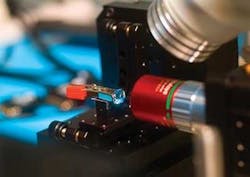Spectroscopy: LIBS determines quality and origin of precious gems
Gemstone appraisal has gone high-tech, thanks to a collaboration between researchers at New Mexico State University (NMSU; Las Cruces, NM) and ultrafast laser manufacturer Raydiance (Orlando, FL). Nancy McMillan, professor and academic head of the Department of Geological Sciences at NMSU and principal investigator of the gemstone project, is using ultrashort-pulse laser-induced breakdown spectroscopy (LIBS) to nondestructively analyze precious gems (see figure).
McMillan’s project aims to illustrate how ultrafast lasers can detect gemstones that were treated to look like real stones, such as chemically coated diamonds, rubies injected with leaded glass to superficially remove flaws, and sapphires that have been diffused with beryllium to produce a brilliant orange color. The research will also test the laser’s ability to identify minerals that are being illegally sold as more expensive ones, such as synthetic forsterite sold as tanzanite. McMillan is also working to build a database that could help pinpoint the origins of individual gems.
Gemstone evaluation typically entails subjective visible examination or microscopic inspection of a stone’s refractive index. While femtosecond and picosecond lasers have been shown to be effective in determining the type, origin, and quality of gemstones, they have not been small, portable, precise, or inexpensive enough to be practical for commercial use. In addition, they can cause collateral damage to the gems and thus reduce their value, according to McMillan.
“Traditional nanosecond lasers create a ‘crater’ in the gem that is visible,” she says. “When you are appraising gems, the origin of the gemstones is very important. You want to be able to determine the gem’s provenance, which means you need a large database of information about each gem, and you won’t get that if you keep putting 100 µm holes in the gems. With the Raydiance laser, we can make a much smaller mark on the stone that can be easily polished out without reducing the weight or quality of the stone.”
McMillan’s work is one of six research projects on the Raydiance laser platform currently under way at NMSU; the other projects include the study of spectroscopic techniques for sensitive detection and identification of chemical species or microorganisms and live imaging of neural and sensory tissue for biomedical applications. Other research groups in New Mexico are also working with the Raydiance laser, including the University of New Mexico, New Mexico Tech, Los Alamos National Laboratory, and Sandia National Laboratories, through a collaborative agreement between New Mexico and Raydiance. The economic-development project is funded in part by a $1 million appropriation from the 2007 New Mexico Legislature.
Raydiance says its laser platform offers several advantages over traditional ultrafast systems for commercial applications (see www.laserfocusworld.com/articles/308751). One of the key differences is the use of a 1552 nm erbium-doped fiber laser instead of the conventional Ti:sapphire laser, which is much larger and more expensive.
About the Author
Kathy Kincade
Contributing Editor
Kathy Kincade is the founding editor of BioOptics World and a veteran reporter on optical technologies for biomedicine. She also served as the editor-in-chief of DrBicuspid.com, a web portal for dental professionals.
